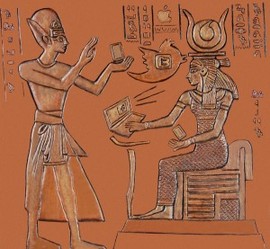While we’re on the subject of the Egyptian Revolution, much has been made of the role of Facebook, Twitter, cell phones and technology in general for enabling the revolt.
 Now a piece of contemporary art has come to my attention that takes off from ancient Egyptian art and adds the technology — from a California sculptor. The Evolution of a Revolution by Adam Reeder was written up today in Ahram Online.
Now a piece of contemporary art has come to my attention that takes off from ancient Egyptian art and adds the technology — from a California sculptor. The Evolution of a Revolution by Adam Reeder was written up today in Ahram Online.
Before we get to that, Ahram Online also had a pretty good article yesterday about Zahi Hawass, who denied all allegations against him. The best article I could find in English about those charges was published on Sunday in Al Masry Al Youm.
In Ahram Online, Hawass also recounted all his achievements since 2002, when he became secretary general of Egypt’s Supreme Council of Antiquities.
Among them are the construction of 47 state-of-the-art museum storehouses at various archaeological sites, complete with alarm systems and televised circuit control, the start of a project to document Egypt’s antiquities, the appointment of 8,000 professional guards, and the assignment of archaeological experts to all airports and seaports in Egypt, to tighten security measures and crack down on smuggling.
Today, Hawass also blogged again on his website, posting an address he would have given to the UNESCO meeting in Paris this week on combatting illegal antiquities trafficking, had he gone, and linking to the Supreme Council’s so-called final list of items missing from the Egyptian Museum.
We shall see. (It is more extensive than, but overlaps with, the leaked list I printed here on Mar. 3. The trumpet and thot[h] and the scribe, for example)
Meanwhile, back in the contemporary world: Reeder, in his sculpture, puts cell phones in the hands of the ancients, lists Egypt, Libya, Algeria, Yemen, Jordan and Morocco in the hieroglyphics — all experiencing protests in one form or another — and adds the symbols for Facebook, Twitter, Apple and Vodafone (which supplied mobile service in Egypt). Significantly, there’s a woman, since they were key in ther revolt.
Ahram Online interviewed Reeder, who has never been to Egypt, but said:
I see my role as one who chronicles the ways technology changes how we interact with our world. I think when the dust settles and Egypt has what it wants, I will make more art about it. For now, I have said what needs to be said, like a journal entry about a very good day.
Except for the casualties. Ahram Online today also carried the story of Ziah Bakir, an artist who worked for the Cairo Opera and who left home on Jan. 28 and never returned.
Photo Credit: Courtesy of Adam Reeder
